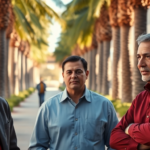United in Diversity: The Asia-Pacific Region’s Path to Inclusive Social Development
The Second World Summit for Social Development held in Qatar in November 2025 shed light on the Asia-Pacific region’s groundbreaking strategies aimed at fostering inclusive, equitable, and sustainable development. The region’s initiatives in social protection, intergenerational solidarity, and transforming the care economy were recognized as crucial for tackling poverty and inequality while providing resilience against climate change. This event, covered by Woke News, underscores significant local impact and community interest in understanding how these global developments affect residents in the United States and beyond.
Revolutionizing Social Protection
Social protection is a cornerstone of reducing poverty and inequality. It has emerged as an even more powerful tool in the face of new challenges posed by climate change. Indonesia’s Program Keluarga Harapan stands out for its success in bolstering household incomes in climate-sensitive sectors. Similarly, Fiji’s Jobs 2.0 and India’s Mahatma Gandhi National Rural Employment Guarantee Scheme have been pivotal in building climate-resilient infrastructure, demonstrating how public work programs can help communities adapt to environmental shocks.
Nepal’s innovative forecast-based financing model, which releases funds for social protection before disasters strike, exemplifies a proactive approach to safeguarding vulnerable populations from environmental crises. These programs, rooted in regional cooperation and supported by the United Nations Economic and Social Commission for Asia and the Pacific (ESCAP), serve as valuable lessons for countries worldwide, including the United States.
Fostering Intergenerational Solidarity
With aging populations becoming a significant demographic trend, policies promoting intergenerational solidarity are more critical than ever. The Maldives and the Lao People’s Democratic Republic have taken bold steps by enacting national policies to address the challenges and opportunities associated with aging demographics. These initiatives emphasize the importance of social cohesion, recognizing that today’s youth are tomorrow’s older generation.
Such forward-thinking policies reflect a commitment to enhancing equity and ensuring that all age groups are valued contributors to society. Empowering older adults through comprehensive frameworks, as seen in these Asia-Pacific nations, offers insights that can be adopted in the United States, where aging populations also necessitate more inclusive policy planning.
Transforming the Care Economy
The care economy is emerging as a crucial area for investment to build inclusive and resilient economies. Malaysia’s Selangor state and the Philippines have both initiated policies to enhance the value of unpaid care work. These measures integrate care into local budgets and demonstrate how subnational governments can transform the care economy through multi-stakeholder collaboration. Moreover, the Republic of Korea’s expansion of parental leave through the “6+6 scheme,” promotes shared caregiving responsibilities, setting an example for rebalancing the division of care work within families.
The United States, grappling with its own challenges in recognizing and compensating care work, can benefit from understanding these models. Efforts to transform the care economy resonate globally, highlighting the interdependence of sustainable development goals and gender equality.
Regional Collaboration and Global Implications
One of the pivotal outcomes of the summit was the emphasis on regional cooperation. The Asia-Pacific region’s diverse initiatives prove that diversity is not a barrier but an asset in crafting people-centered solutions. Frameworks such as the Action Plan to Strengthen Regional Collaboration on Social Protection highlight the potential for resource sharing and knowledge exchange across borders.
For the United States and other global players, the Asia-Pacific’s commitment to multilateralism and solidarity offers a model to address shared challenges like climate change, social inequity, and aging populations. By integrating these lessons, countries can craft policies that are both locally grounded and globally informed.
Looking Forward: A Model for Inclusivity
As ESCAP continues to support these initiatives, it provides spaces for policy dialogue and mechanisms to monitor progress towards the 2030 Agenda. Improved data collection and reporting are critical for tracking equity-focused development and for ensuring that no community is left behind.
The Asia-Pacific region’s contributions at the summit are noteworthy not only for their innovation but for their deep commitment to human dignity and resilience. Their progress illustrates a path to sustainable and inclusive social development that is achievable through coordinated action and shared responsibility.
For local communities worldwide, including the United States, these developments underscore the importance of learning from global partners to augment local impact and community interest. As these efforts continue, they represent the potential for transformative change, propelled by cooperation, equity, and a shared vision for a more inclusive world.
In the context of previous events and ongoing issues in the United States, focusing on the potential applications of these Asia-Pacific strategies could align well with initiatives to improve local infrastructure resilience or demographic policy adjustments. The news from the summit indicates a future where collaborative global efforts enhance the quality of life for all, reinforcing the notion that development must be for all, by all.







